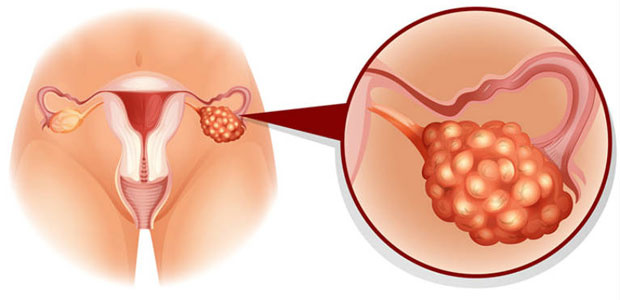
What is Ovarian Cancer?
A woman has two ovaries, which are part of the female reproductive system. Each is the size of a walnut and located at the pelvis on either side of the womb (uterus). The ovaries contain eggs and produce the female hormones, estrogen and progesterone. The ovary is made up of different cells, each performing its own function. When these cells grow abnormally, a cancer is formed. Hence there are many types of ovarian cancers but the most common is called epithelial cell cancer, which arises from the lining of the ovary. In the initial stage, the cancer is confined to the ovary but as it grows bigger, it can spread via the following routes:
Within the abdomen, forming deposits on the intestinal wall, liver capsule and lining of the abdominal cavity.
Lymph glands in the pelvis and abdomen.
Eventually via the blood stream to the lungs and bones.
What are the Signs and Symptoms?
Epithelial ovarian cancer usually does not have signs or symptoms in the early stage. The symptoms of ovarian cancer are also non-specific. The following are the common complaints:
Bloated feeling in the abdomen
Backache or ache in the legs
Abdominal distension
Abdominal discomfort
Change of bowel habits
Urinary complaints
Abnormal vaginal bleeding
Loss of weight
Are You at Risk?
The following are associated with a high risk of ovarian cancer:
High fat diet
Infertility or not having children until late in life
Early menarche and late menopause
Family history of ovarian, breast or colorectal cancer
How is Ovarian Cancer Diagnosed?
Diagnosis is based on the physical examination of the pelvis and tests such as:
Pelvis examination by the doctor. An ovarian cancer is suspected if:
– The ovary is enlarged
– There is an abdominal lump
– There is excessive fluid in the abdomen
Ultrasound scan of the pelvis. The scan is either performed on the abdomen or via the vagina. CA-125 is a tumor marker that is often raised in the blood of women with ovarian cancer. However, high CA-125 levels may be due to other causes. CT scans of the abdomen and pelvis are a series of detailed pictures of areas inside the body generated by X-rays. This scan is useful in diagnosing ovarian cancer and studying the extent of the spread of cancer.
Biopsy is the removal of tissue for microscopic examination in order to make a diagnosis of the cancer. To obtain the tissue, a laparatomy (abdomen operation) is performed. If cancer is suspected, the entire ovary will be removed (oophorectomy).
How is Ovarian Cancer Treated ?
The treatment for epithelial ovarian cancer are surgery (laparotomy), chemotherapy and radiation therapy.
Laparotomy is an operation on the abdomen. Tissue samples are removed and sent for microscopic examination. The results of these biopsies will show the type and extent of the cancer. If the diagnosis of cancer of the ovary is confirmed, the surgeons will remove the ovaries, fallopian tubes, the uterus, cervix, omentum (thin tissue covering the stomach and intestines), lymph nodes and all visible tumors. In certain cancer types, if the patient desires to have children, it is sometimes possible to remove only the affected ovary and the fallopian tubes. In more advanced cancer, the pelvic lymph glands and secondary cancers in the abdomen are also removed (cytoreductive surgery).
Chemotherapy is usually recommended for ovarian cancer in the advanced stage. For patients with early cancer of ovary, chemotherapy can also be given after complete surgical removal of cancer, in order to prevent recurrence. It is usually given via an intravenous drip.
Radiotherapy is occasionally used, especially if the tumor is confined to the pelvis. It is also used to destroy cancer cells that remain after surgery.
After Treatment
Temporary abstinence from sexual intercourse for 6 weeks to allow for normal healing.
If both ovaries are removed, the patient will experience the symptoms of menopause. Hormone replacement therapy (HRT) may be prescribed to relieve the menopausal symptoms.
Regular check up with blood tests and if necessary, X-rays should be kept with the oncologist.
Patients should resume normal, healthy lifestyles after treatment.






 Telephone:
Telephone: